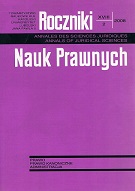Władza sądownicza w ustawach zasadniczych w Polsce w latach 1989-1997
The Polish Judiciary Authority in the Years 1989-1997
Author(s): Bogumił SzmulikSubject(s): Law, Constitution, Jurisprudence
Published by: Towarzystwo Naukowe KUL & Katolicki Uniwersytet Lubelski Jana Pawła II
Keywords: the judiciary authority; Constitution; courts; Tribunals; judges; władza sądownicza; konstytucja; sądy; trybunały; sędziowie
Summary/Abstract: One of the three powers in the division of State authority is the judiciary. Its competences may not coincide with those of the others, which practically is a general rule in the relations between the legislative and the executive powers. The outcome of the Polish Round Table Talks and signing of the agreement of 5 April, 1989, was the amendment of the Constitution. The section devoted to the judiciary power now included the principle of irremovability of judges and their appointment by the President upon a motion of the National Judicial Council (Art. 60, par. 1). The President was granted the right to appoint presidents of the Supreme Court (Art. 61, par. 4), while the First President was elected (appointed and dismissed) from among the Supreme Court judges upon a motion of the President by the Sejm. These amendments were subsequently supplemented with the principle of subordination of prosecutors to the Justice Minister by way of a constitutional review on 29 December, 1989. The Little Constitution of 1992 envisaged two new solutions regarding the judiciary, apart from the division of power enshrined in Article 1. Firstly, the Little Constitution altered the interpretation of the previous provisions of the Constitution with respect to the independence of courts, and, secondly, Article 5 gave the Supreme Court the right to adjudicate on the validity of a vote and the validity of appointment of an MP against whom an objection has been formally raised. By virtue of Article 26 of the Little Constitution the latter provision also applied to the Senate and senators. Unlike the solutions used in the Little Constitution, the new Constitution of 1997 adopted a broad understanding of the notion of “the judiciary authority”, both in terms of structure and functionality. Chapter VIII, entitled “Courts and Tribunals”, lays down normative regulations of the judiciary. Here are contained the following regulations applying to: courts (Art. 175-185), the Constitutional Tribunal (188-197), and the Tribunal of State (198-201). Overall, judging the conception of the judiciary power enshrined in the Polish Constitution of 1997, it must be stressed that regardless of its doubtless significance for the judiciary it brings Poland closer to proven international standards in terms of citizens’ rights to be heard before court and of judicial independence.
Journal: Roczniki Nauk Prawnych
- Issue Year: 18/2008
- Issue No: 2
- Page Range: 133-147
- Page Count: 15
- Language: Polish

